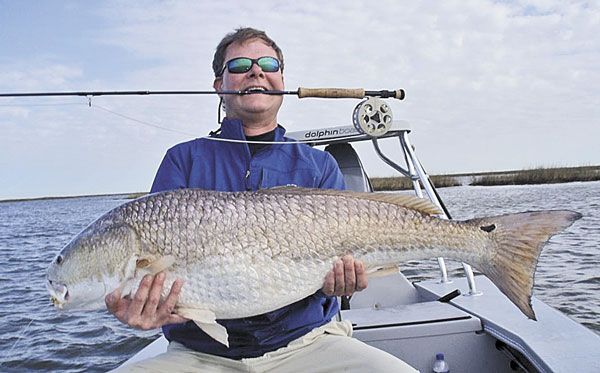
Ironically, it’s the fox squirrels — and not their smaller cousins — that draw hunters to Cat Island.
The start of this month usually finds me feeling tropically depressed. Another year, another storm that has ravaged one of my coastal fishing spots. Perhaps I shouldn’t feel so down, now that I know those storm clouds bring a silver lining.Uh, make that red lining.
Fall has always been a time of anticipation and high excitement for those of us who stalk Mr. Poisson Rouge with the long rod. The heat of late summer either forced most of the fish out of the skinny water, or cooked the ones that remained, making them lethargic.
But now radiative cooling, along with a succession of fronts, has cooled the shallow ponds.
Cooler water holds more oxygen. So now as reds are pouring back in the ponds, they’re getting high on the high O. They’re frisky and ready to fight!
An added benefit is that those cool fronts flush much of the high water that late summer had flooded into the marshes. It pushes bait into the ponds and bayous, where waiting redfish, specks, drum and sheepshead pound them into easy meals.
For the shallow-water enthusiast, especially those who fish from kayak and canoe, lower water levels also expose the fish more readily. Those backs are back!
As in the 20+ years that I’ve been flyfishing the marsh, I’ll be out this fall with any combination of 6- to 8-weight outfits in my arsenal. The lighter rods are for specks and small reds on calmer days. The heavier 8-weight is for when I encounter bigger fish or the wind kicks up.
My selection of fly patterns for reds will include crab patterns, Clousers, Charlies, Kwans, EP Redfish Specials, Seaducers and Stu Apte Tarpon flies.
Did I miss something? Absolutely! Spoon flies and Poppers — never leave home in the fall without them. They can account for a majority of your fish as we progress toward winter.
Now if we enter October with a tropical storm having come ashore in the northern or western Gulf, then the game plan changes just a bit. Let me explain.
For years there had been stories of bull reds in the marshes — or as we call them, redzillas. The incidents were as rare as a Tulane win in Tiger Stadium, but they did occur. Biologists contended that these were anomolies, that once a redfish reached a certain age, and thus a certain size, usually around 10 pounds, that fish was gone from the marsh never to return.
But in the late 1990s, sightings and even landings became more frequent. Since Katrina, the incidents have become quite common, especially among flyfishers and kayakers. We’re talking about fish 15 to 30 pounds or more.
Numerous tagging studies of juvenile reds have found them to be basically home-bodies, only leaving the neighborhood once spawning age. But as adults, they become nomads. Tagging studies done in Mississippi and Florida have shown adults travel extensively, often up to 200 miles.
So why are some of these adult reds coming back into our marsh? I posed this question back in June to Harry Blanchet, marine finfish program manager for the Department of Wildlife and Fisheries. He observes that with the accelerated loss of wetlands to open water, particularly in Plaquemines, Jefferson, Lafourche and Terrebonne parishes, these fish now have a short, easy-to-navigate path from the Gulf to the upper marshes.
All they need is a little push.
Glen Davis of the Magnolia Fly Fishers in Jackson has been intrigued about the idea of a “redzilla surge” that corresponds to tropical storm surges. Our theory is that every fall there would be a few bull reds who decide to head into the marshes after their mating dance. But if a tropical storm (or hurricane) brings a surge of water, then a larger percentage of bulls ride the wave up the estuary.
So the hunt for redzillas in fall is not so much how to look for them, but where to look.
If the water levels come up just a few feet along any section of coast, then the marsh above it gets my attention. Hopedale and the eastern shoreline of Lake Borgne are on my radar almost every year since Breton Sound is thick with bulls, and just about any storm in the Gulf brings water levels up there. The same holds true for Port Sulphur (bulls coming from Four Bayous) and Chauvin (bulls coming from Timbalier).
The other thing to keep in mind is that these big fish are more likely to be found along banks of lakes, bayous and canals than in small ponds.
My home waters are along the Highway 1 corridor from Galliano to Grand Isle. Here I know the redzillas have arrived when I see the crowds along Bayou Lafourche just below the levee wier in Golden Meadow.
Last fall we stopped by to chat with the folks, and observed a 27-pound red and 21-pound drum landed. Seeing this changed the game plan. The 9-weight outfit was assembled as we loaded up the boat, while the 8-weight remained in the vehicle. For most of the day, nothing big enough to warrant the heavier rod ate my flies.
Just as we were ready to call it a day, my partner noticed a huge tail sticking out near some pipes. I cast the Charlie, but it landed 4 feet from the tail. Too far away, I thought.
Not really. The fish was 4 feet long! It fell right by his face. He ate, I set the hook and as drumzillas will do, he just sat there waiting for me to tow him in. Believe me, if that had been a redzilla, he would have done the towing — to Cuba.
There are big fish out there. Be prepared.


